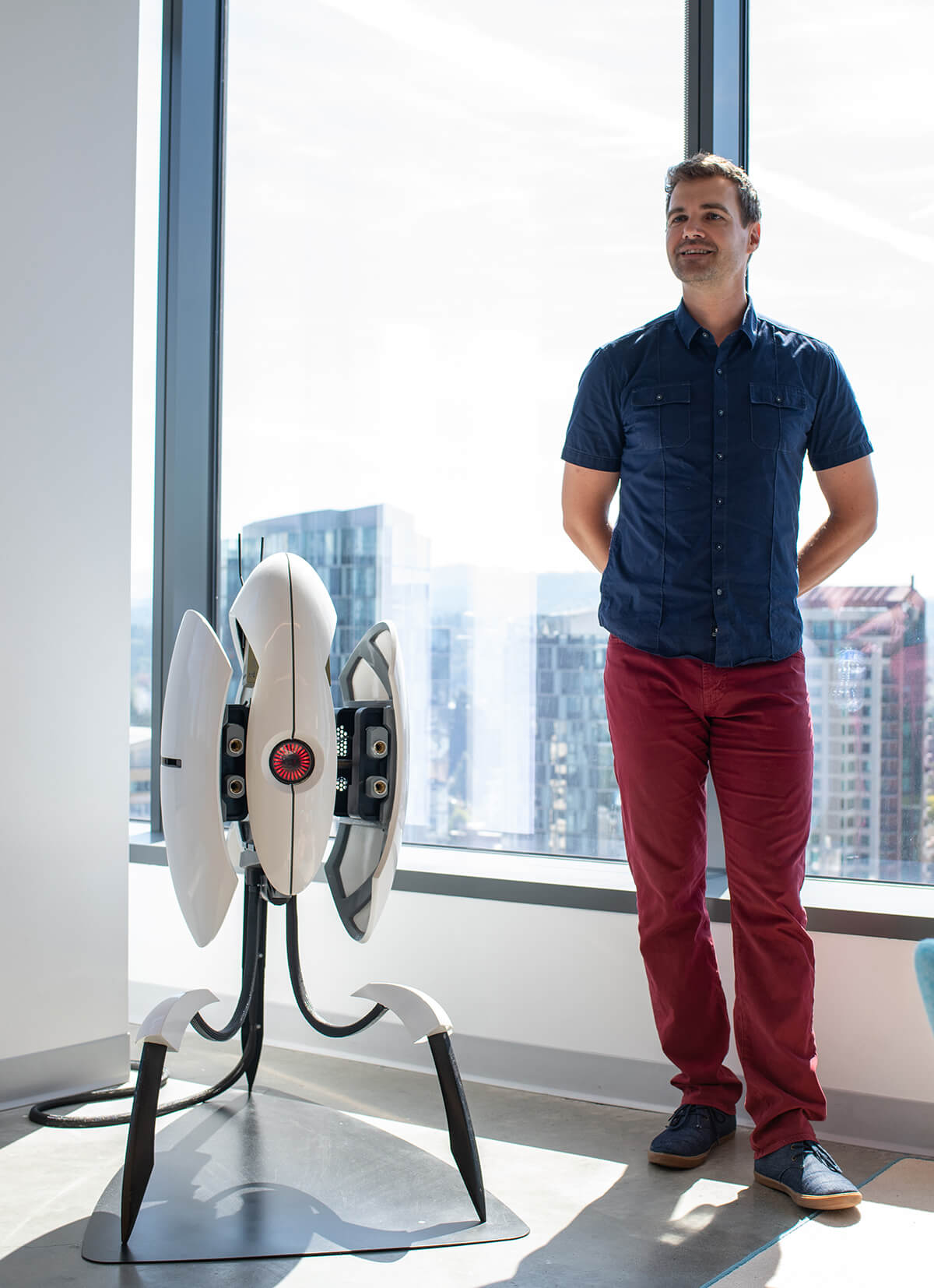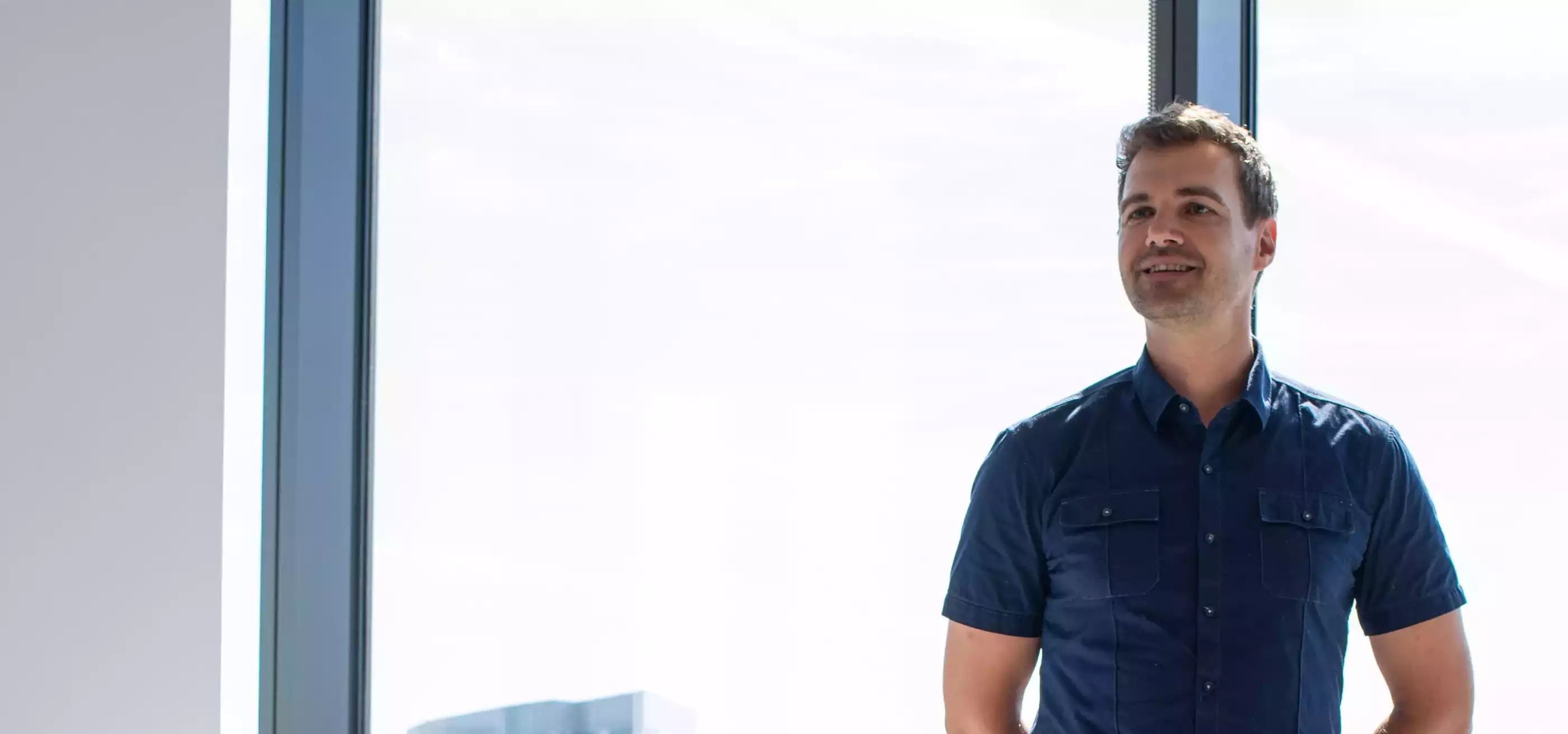DigiPen welcomed 2006 graduate and 15-year Valve developer Kerry Davis to campus on Saturday, September 14, for a special guest lecture. Presenting to a packed Plato Auditorium filled with students and Valve fans alike, Kerry spoke at length about his unusual journey into the game industry, as well as his recent experiences working on his company’s upcoming VR flagship game.
You can watch the full presentation in the video below.
“People always ask me, ‘How did you end up at Valve?’ And I don’t really have an easy answer for that, because to be honest, I wasn’t trying to work at Valve,” Davis said. “In fact, before I started at DigiPen, I wasn’t even intending to work in video games at all. It wasn’t even on my radar.”
While Davis always had a passion for problem solving, his earliest childhood ambitions were far removed from the world of technology. As the child of two professional music teachers, Davis says he grew up surrounded by singers, musicians, dancers, and artists. It was an environment that, by age 10, naturally led him to activities like dance competitions, community theater, and even some local modelling gigs.
“By this point in my life, I knew what my career was going to be. I was going to be a Broadway star,” Davis says. “But when I wasn’t dreaming about my future stardom, I was obsessed with puzzles and brainteasers and games, and I would burn through these [activity] books faster than my parents could buy them. And then in school, my favorite subjects were math and science, because — for me — math problems and science experiments are just another type of puzzle that I got to solve.”
As it turned out, that passion for puzzles would resurface time and again throughout his late teens and early 20s. After graduating from high school, Davis’ first route to college was by way of a theater technical production major at Carnegie Mellon University in Pittsburgh. While there, he became fascinated with the role of technical director, the person responsible for taking a production designer’s sketches, models, and concept art for a theatrical show and translating that creative vision into a working, executable plan.
“Now doesn’t that sound like the ultimate puzzle?” Davis said. “I really enjoyed it.”
Ultimately, however, it was a job that also entailed a lot of time spent in the scene shop, where the physical labor of welding and woodwork resulted in plenty of sawdust, slivers, and burns. After spending two years in the program, he decided it wasn’t the right path, so he moved to Las Vegas for another shot at his original childhood dreams.
It wasn’t until almost a decade later, however, that his ultimate calling would manifest itself by way of a magazine article about a college called DigiPen Institute of Technology in Redmond, Washington.
“It talked how about they’re teaching kids to make video games. And I thought, ‘What a crazy world we live in!’” Davis said. “So I kept reading the article, and then I got to the description of a game programmer. And it said that they take the creative vision of a game designer. They use math and science and technology to create a detailed set of instructions, which then produces what is essentially interactive theater. … I thought, ‘This is exactly what I’d been looking for! Now I see the parallels, and this time there’s no sawdust or splinters.’”

He eventually enrolled in the BS in Computer Science in Real-Time Interactive Simulation program, a path that would lead him to his current job. Fast forward to the present day, and Davis is thrilled to be working not only at Valve, a studio renowned for its history of video game innovation, but also at the forefront of a very new form of “interactive theater,” otherwise known as virtual reality.
While it’s an area of game development that comes with its fair share of sometimes literal headaches — whether from the occasional bout of motion sickness or accidental collision with office furniture — it’s also an area where developers have plenty of opportunity to break new ground.
Davis presented at length on one particular case study from his current project, detailing his iterative approach to simulating a real-life doorway. Whereas his earliest and simplest iterations failed to capture the authentic experience of opening a door (since most doors are not opened by pressing a button), the move towards greater realism introduced new problems altogether. In one midway prototype, Davis created a hinged, one-way door that players would have to pull open by way of a handle. While the people who pulled the door handle had no problems, the players who initially tried to push the door would end up in a confusing situation. The act of pushing would move their physical hand forward in space, but their in-game hand would be stuck further back behind the virtual barrier of the closed door. This, in turn, caused a spatial disconnect that made it harder to place the physical hand in the correct position to regain control of the virtual door handle. In that case, Davis said, the best solution was to make sure that doors opened both forwards and backwards.
“It’s not common, [but] it’s not unacceptable. It feels like a cheat,” Davis said. “But here’s the interesting thing. When players play through a bunch of doors that open both ways, they very rarely realized that they could have opened the door the other direction. They didn’t know they were two-way doors, and that’s because the experience was accurate. They went to a door. They decided, by whatever means, that this is the way it’s going to open. They tried it. It worked. They walked through it. And they kept playing.”
The overall experience, he said, taught him a valuable lesson: Increasing the accuracy of the simulation did not necessarily result in a more “realistic” experience. While the door scenario was just one tiny example of a new type of challenge for VR developers, Davis said there are many other problems like it that are still waiting to be solved. The game development students of today, he said, will likely be entering the industry right at the “sweet spot” for VR innovation.
“It’s a fertile ground for interesting, innovative solutions,” Davis said. “The opportunities that are in front of you are going to be incredible.”
